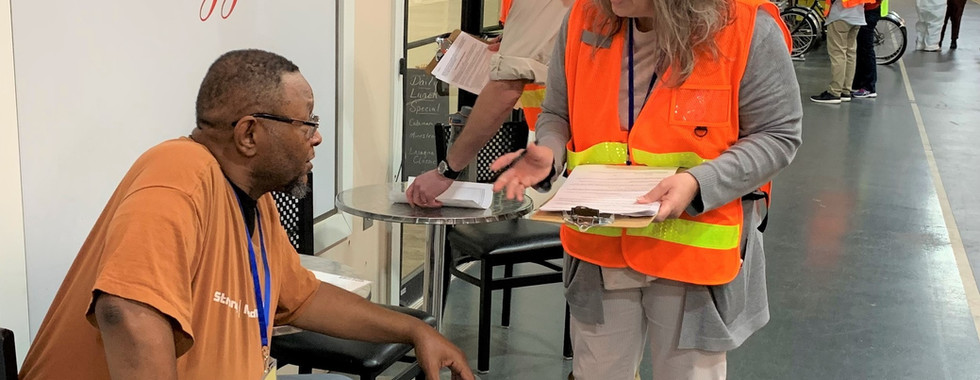Training the Best for the Worst: A Tour Inside FEMA's Center for Domestic Preparedness at McClellan
- Kassidy Nance
- Jan 16, 2024
- 3 min read
"The 'best' are our first responders, those willing to risk their lives for the safety and security of fellow Americans. The 'worst' is man-made and natural disasters that can strike anywhere, at any time," explained Richard Brewer, Director of External Affairs at the Center for Domestic Preparedness (CDP), to myself and McClellan Development Authority Executive Director Julie Moss in a large boardroom at the CDP headquarters on the morning of Tuesday, November 14, 2023.
We had connected with Brewer the month before with the hopes of writing a feature piece about the CDP's national training operations which are headquartered at McClellan, but he offered something even better which we couldn't pass up—a personal tour of their campus, which began, like all organizational overviews, with an introductory presentation.
The genesis of the Center for Domestic Preparedness traces back to the harrowing Sarin nerve agent attack in Tokyo by the Aum Shinrikyo terrorist cult in 1995, which spurred an overwhelming demand for civilian responder training in the United States to be prepared to handle similar crises domestically. The next year, the Nunn-Lugar-Domenici Domestic Preparedness program was started as part of the Defense Against Weapons of Mass Destruction Act, allowing first responders to train at the U.S. Army Chemical School at Fort McClellan.
Brewer explained, "When the base was slated for closure, some very smart people suggested they keep training first responders here," and the Center for Domestic Preparedness was born. The CDP's presence at McClellan has not only repurposed many of Fort McClellan's claims to fame (like the Noble Army Hospital and former Chemical School buildings), but has also brought a $255 million annual economic impact to Calhoun County.

Following the briefing, Brewer showed us a map of their campus, which comprises over 50 buildings spread across 186 acres and three primary training sites: the ARTC, COBRATF, and Noble Training Facility.
The ARTC (Advanced Responder Training Complex), which is currently undergoing major upgrades and renovations, prepares responders to deal with commonplace hazards, including an industrial park, a mock subway station, and a simulated street scene with businesses.
[Photos feature live training sessions at the ARTC on the simulated street scene and subway]
The COBRATF (Chemical, Ordnance, Biological and Radiological Training Facility) is where civilian responders receive hands-on training to effectively respond to real-world incidents involving chemical, biological, explosive, radiological, and other hazardous materials.
There, Gary Milner, Assistant Director of Training of the COBRATF walked us through the various training settings within the mock town of Fisherville, including an apartment, a bar, a commercial kitchen, and more. He also showed us the training bays where responders train with actual toxic biological materials and chemical agents to gain confidence in both their skills and the personal protective equipment they wear when responding to hazardous material incidents.
The training at the COBRATF is the only of its kind in the nation, with advanced security measures and rigorous safety protocols that Milner says has helped sustain their long-standing record of zero exposures.
[Photos feature live training sessions at COBRATF, a display of the various
Hazmat suits used in training, and an aerial view of the mock town of Fisherville]
Our tour next led us to the Noble Training Facility just past 11 am, when the mock hospital environment was in full swing, with nursing students, EMTs, instructors, and technical staff bustling about; yet the chaos was structured and intentional, and resembled everything about an operational hospital except for real-life patients.
The setting of this specialized medical response training could not be more appropriate, as the facility was once the Noble Army Hospital during Fort McClellan's operation, serving everyone from privates to generals and their families for over 40 years. Today, the Noble Training Facility is the only hospital facility in the nation dedicated solely to training healthcare professionals in disaster preparedness and mass casualty response, featuring exercises with ambulances and role-players, involving more than 100 patients who must be triaged.
[Photos feature live training scenarios at the Noble Training Facility,
prop wounds/bodily fluids, and the room of training dummies]
Since 1998, the CDP has trained more than 1,400,000 state, local, tribal, and territorial responders through various means, including 51 hands-on courses, 64 virtual instructor-led courses, 14 totally online courses, and several microlearning courses accessible via YouTube. Plus, all training is federally funded at no cost to the trainees.
"It's an astounding experience to get this firsthand look of the state-of-the-art training taking place at the CDP training sites," said MDA Executive Director Julie Moss. "We are thrilled to know so many responders from across the United States visit our beautiful community to better protect the nation from disasters."
We extend a huge thank you to Richard Brewer and Gary Milner for lending their time and sharing their expertise during our tour of the Center for Domestic Preparedness, as well as the 1,000+ CDP employees who spend each day 'training the best for the worst.'
You can keep up with the CDP's training initiatives on their Facebook page, and learn more about their training opportunities at cdp.dhs.gov/training.
.png)

























